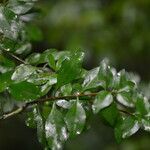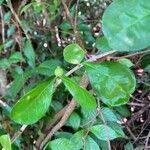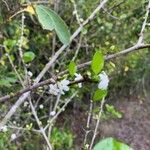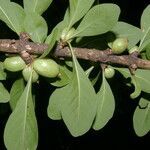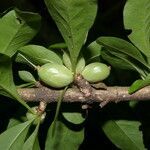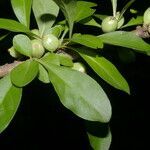Shrubs or trees to 6 m tall, the branches well spaced, terete or 4-angled, usually distichous, the branchlets angular, stout, glabrous, short or long, 2-15 cm long, the bark drying dark, often cracking, usually with 2 stout subulate spines at the subterminal position or occasionally along branchlets, the spines bicornuate in appearance, spreading, (0.6-)1.0-2.0 cm long, lignose. Leaves polymorphic, broadly obovate-oblong, 1.0-5.5(-9.0) cm long, 0.8-3.2(-5.0) cm wide, variable in size on the same branch, rounded or obtuse at the apex, occasionally truncate, attenuate acute at the base, the costa prominulous above and beneath, the lateral veins 4-5, at first strict, then arcuate and anastomosing to form a submarginal undulate vein, the latter ca. 5 mm from the margin, the margin conspicuously emarginate, chartaceous to coriaceous, concolorous, glabrous, lustrous; petioles absent or to 1 mm long; stipules subtriangular, to 2.5 mm long, to 3 mm wide at base, apiculate. Flowers clustered at the apex of the twigs, perfect, sessile or subsessile, the hypanthium and calyx to 1 mm long, pubescent, the calycine teeth 5, erect, subulate, corolla white, the tube 4-8 mm long, cylindrical, the lobes 5, lanceolate, often longer than the tube, villose at the mouth within; stamens 5; the anthers oblong, ca. 4 mm long, included or exserted; style slender, the stigmas short. Fruits sessile, rotund, 1.0-1.2 cm in diam., glabrous or minutely puberu-lent, occasionally farinose, delicately ribbed.
More
A shrub or small tree. It grows 2-6 m tall. The leaves are leathery and spiny. They are clustered near the tips of the branches. The leaves are simple, round and 5 cm long. The flowers are white and tube shaped. The fruit are white. They are almost black inside.
